

AWS_Amazon_VPC_Connectivity_Options.pdf. What Is Amazon Relational Database Service (Amazon RDS)? - Amazon Relational Database Service. Building Your Cloud Infrastructure_ Converged Data Center without Dedicated Storage Nodes.pdf. Implementing IBM SDN for VE.pdf. Migrating Database to Amazon RDS. What is Erp? (Learn in 2 minutes!) Introduction to ERP Systems.
Odoo. Home - Learn Amazon Web Services. AWS: the good, the bad and the ugly. Here at awe.sm we have been hosted from the beginning on Amazon Web Services (AWS).
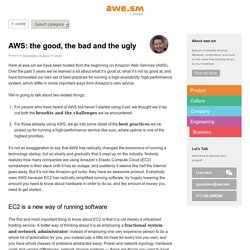
Over the past 3 years we’ve learned a lot about what it’s good at, what it’s not so good at, and have formulated our own set of best practices for running a high-availability, high-performance system, which differ in some important ways from Amazon’s own advice. We’re going to talk about two related things: For people who have heard of AWS but haven’t started using it yet, we thought we’d lay out both the benefits and the challenges we’ve encountered.For those already using AWS, we go into some detail of the best practices we’ve picked up for running a high-performance service like ours, where uptime is one of the highest priorities. It’s not an exaggeration to say that AWS has radically changed the economics of running a technology startup, but so slowly and gradually that it crept up on the industry. EC2 is a new way of running software.
Google Cloud vs AWS: a comparison - Cloud Academy Blog. The “Google Cloud vs AWS” topic is a common discussion argument among our members.
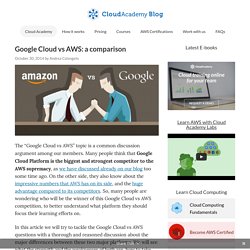
Many people think that Google Cloud Platform is the biggest and strongest competitor to the AWS supremacy, as we have discussed already on our blog too some time ago. On the other side, they also know about the impressive numbers that AWS has on its side, and the huge advantage compared to its competitors. So, many people are wondering who will be the winner of this Google Cloud vs AWS competition, to better understand what platform they should focus their learning efforts on. In this article we will try to tackle the Google Cloud vs AWS questions with a thorough and reasoned discussion about the major differences between these two major platforms.
We will see what the strength and the weaknesses of both are, how to take advantage of them, and how to start learning both. AWS Webcast - Getting Started with Amazon Web Services. Best Practices for Getting Started on AWS. Backup and Archiving in the AWS Cloud. Understanding AWS Security. Does AWS use SDN (software defined network) technology? - Quora. SDN secrets of Amazon and Google. Those seriously considering SDN (software-defined networking) must continually adjust to the new definitions, technologies, and possibilities presented by this fundamental shift in networking technology.

Everyone would like a clearer view of where SDN is heading -- so why not examine what the early adopters are doing, many of them with the largest infrastructures around? In this week's New Tech Forum, Chloe Ma, director at Juniper Networks, takes us on a tour of how massive-scale service providers are using SDN, all the way from Amazon Web Services to Google's software-defined WAN technologies. --Paul Venezia What enterprises can learn about SDN from providersFor the last year or so, SDN has been the buzz of the networking world, and for good reason: SDN is transforming the industry.
As with any emerging technology, there's room for debate. One thing has remained constant: The need for enterprises to build an elastic infrastructure that empowers today's dynamic business applications. Software-Defined Networking (SDN) Definition - Open Networking Foundation. What is SDN?
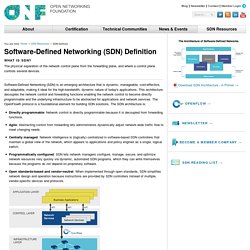
The physical separation of the network control plane from the forwarding plane, and where a control plane controls several devices. Software-Defined Networking (SDN) is an emerging architecture that is dynamic, manageable, cost-effective, and adaptable, making it ideal for the high-bandwidth, dynamic nature of today's applications. This architecture decouples the network control and forwarding functions enabling the network control to become directly programmable and the underlying infrastructure to be abstracted for applications and network services. The OpenFlow® protocol is a foundational element for building SDN solutions. Three Ways to Protect EC2 Instances from Accidental Termination and Loss of Data · Alestic.com. Here are a few little-publicized benefits that were launched with Amazon EC2’s new EBS boot instances: You can lock them from being accidentally terminated; you can prevent termination even when you try to shutdown the server from inside the instance; and you can automatically save your data storage when they are terminated.
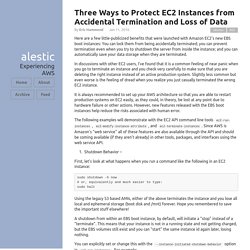
In discussions with other EC2 users, I’ve found that it is a common feeling of near panic when you go to terminate an instance and you check very carefully to make sure that you are deleting the right instance instead of an active production system. Slightly less common but even worse is the feeling of dread when you realize you just casually terminated the wrong EC2 instance. It is always recommended to set up your AWS architecture so that you are able to restart production systems on EC2 easily, as they could, in theory, be lost at any point due to hardware failure or other actions. Shutdown Behavior –
Instance Types. Use Cases Small and mid-size databases, data processing tasks that require additional memory, caching fleets, and for running backend servers for SAP, Microsoft SharePoint, cluster computing, and other enterprise applications.
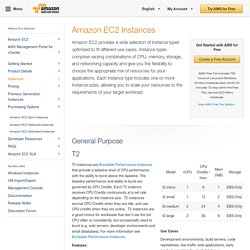
*M3 instances may also launch as an Intel Xeon E5-2670 (Sandy Bridge) Processor running at 2.6 GHz. How to create EC2 instance in AWS Amazon Cloud. 7 Steps to Select the Right Architecture for Your Web Application. Webinar: What Is AWS? Integration Enterprise Mind Map official. What Is Amazon EC2? Amazon Elastic Compute Cloud (Amazon EC2) provides scalable computing capacity in the Amazon Web Services (AWS) cloud.
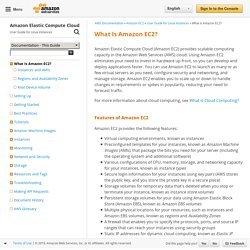
Using Amazon EC2 eliminates your need to invest in hardware up front, so you can develop and deploy applications faster. You can use Amazon EC2 to launch as many or as few virtual servers as you need, configure security and networking, and manage storage. Amazon EC2 enables you to scale up or down to handle changes in requirements or spikes in popularity, reducing your need to forecast traffic. Openstack, AWS, HyperV, VMware. Who Uses These Cloud and Virtualization Systems?

OpenStack, AWS, Hyper-V and VMware are different services offering cloud computing or virtualization services. Let's take a closer look to see the advantages of each, as well as look at some companies using them.